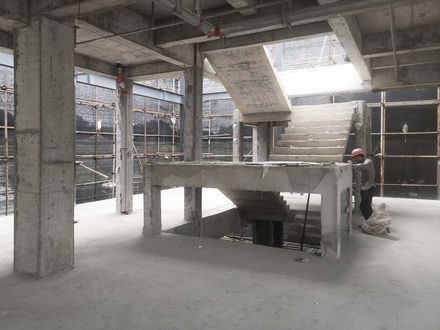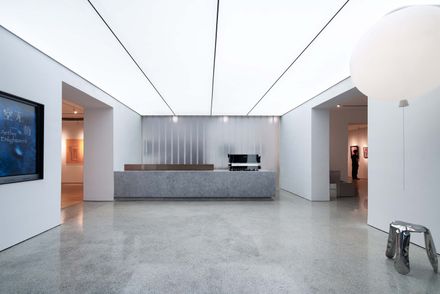
Suzhou Iris Art Realm
LOCATION
Jiangsu, China
CATEGORY
Gallery, Renovation
PHOTOGRAPHS
Qingshan Wu
DESIGN TEAM
Hao Ruan, Yuan Zhan, Lei Zhang, Qiuyan Zhang, Zhedong Lao, Yifan Zhao, Anran Ke
Iris Art Realm is located on the banks of Li Gongdi, Industrial Park Lake Suzhou. It’s a renovation project with children's art education and exhibition as its main function. Its architecture, interior and soft decoration all designed by LYCS Architecture.
Li Gongdi is located in the core area of Suzhou CBD which is under construction. The unique geographical location, historical precipitation and multi-cultural "soul-input" make Li Gongdi’s commercial district become one of the most prosperous commercial districts in Suzhou area.
How to rationalize and reorganize the spatial structure, the building facade and the interior space of the current building to give it a new life, and to create a wonderful encounter with art for people become the biggest challenge from the beginning of design.
Louis Isadore Kahn said "Natural light gives the character of space, and also gives the life of architecture. The life of architecture is generated by the illumination of light. Based on this, no space can really exist unless it gives life to architecture.
” The designers' conception is thus unfolded. The whole design of the project can be said that "light" participates in the creation and re-organization of space.
Facing the current situation of the building, the designers decided to ensure the integrity of the original building structure, at the same time, subtract the rectangular volume of different scales to form rich spatial forms and levels, to create multi-scale and multi-dimensional space for the introduction of light, so that shadow and space generate infinite possibilities.
The current structure of the building is relatively rectangular, so the width and depth of the building are too large, and the scale of the existing atrium cannot meet the lighting needs of the inner space. This design expands the original atrium and arrange all functional spaces around it. U-glass is used as the roof material to ensure the sufficient introduction of light.
A pedestrian staircase spanning three floors is inserted into the space and becomes the flowing soul of the entire gallery space. It connects and activates all the spaces, and is also the most impressive indoor installation art in the museum.
The glass on top of the atrium is arranged in an orderly manner. The sunlight falls gently through the skylight, forming mottled light and shadow on the white walls. The window frame uses the minimalist design language.
The atrium on the south side of the building is selected for a double height design, providing a space flow interface between the enclosed exhibition hall and the external light.
U-glass materials and high windows are used to avoid direct sunlight to the exhibition space, and the light is selectively accepted, blocked or weakened.
The stable light filtered by the U-glass skylight is introduced into each interior space, therefore, the atmosphere of tranquility is created, bring people the guidance of unrestrained thinking and triggers infinite reverie.
Meanwhile, the semi-permeable U-glass replaces the solid wall in the facade, blurring the boundary between inside and outside, making the atrium space become the buffer and transition between interior and exterior, in which the existence of outdoor space can be realized and sensed.
The design of the atrium replaces superfluous decorations with a minimalist architectural language. The bare steel frame structure and the most original building materials restore the beauty of the structure itself.
The exhibition hall, adjacent to the side atrium, is surrounded by solid walls to form a nearly enclosed space. Only one door opening to introduce the natural daylight that first passes through the U-glass.
The light is really faint after being filtered through a double layer glass. The space with strong contrast between bright and dark is only separated by a wall, in which people seem to pass through the tunnel of spatial-temporal transformation, and have a feeling of trance through space-time corridor.
The wonderful occurrence of thoughts about fantasy and reality in people's mind has also tempered people's deep thinking and peace. Different from traditional art galleries, the requirements on environment and light of children's art exhibition space is more relaxed and flexible, and its exhibition forms are more diversified.
Based on the conditions of the landscape environment, existing and surrounding buildings on site, the design creates four categories of exhibition halls with different spatial feelings through the changes of light.
A recessed space on the south side of the building indicates the main entrance. Simple lines and grey and white tones are important design elements of the interior space. The partition between the entrance and the atrium is made of U-glass instead of solid wall, which penetrates the space and extends the line of sight. The vertical lines perfectly play the effect of visual separation and spatial-temporal interweaving.
Three equal rectangular volumes are subtracted from the west side of the building to form a sequence of outdoor landscape platforms. The whole stone wall is replaced by U-glass, and the strong permeability of light is filtered and transmitted to the interior.
The whole exhibition space seems to be immersed in a gentle atmosphere. The outdoor landscape is subtly connected with the people's sight inside, and the boundary between the interior and exterior space visually becomes blurred and soft.
The half-way high side atrium, on the west side of the second floor, allows the light to penetrate into the interior through the skylight, creating a strong contrast between the light and shadow generated and the pure white wall, as if a flowing "light volume" was placed in the exhibition hall.
The change of time brings infinite possibilities to light and shadow, breaks the freeze of space, and creates depth for space. When you are in the gallery reflecting or communicating in front of art, light seems to flow unexpectedly with time.
Interior light well extends upward the public space, and the falling light and the interior light meet by chance. The rich level of the light makes the space dynamic. Two simple but contrasting materials, plain concrete and white paint, create a visual boundary between the exhibition space and the public transport space.
In order to appropriately introduce the line of sight between people and the external nature in the process of viewing the exhibition, and fully echo the natural landscape of Li Gongdi where the Iris Art Realm is located, glass curtain wall is used in some exhibition halls to introduce more natural light into the interior space.
The strong permeability of the light source is weakened by a large area of walls. The window frame standardizes the scope of light falling to the ground and leads people to stop, stay and play. The corridors connect each exhibition space, which ensures people's continuous experience during the viewing process.
Corridors as the secondary space of the gallery, the designers do not do too much concealment, but make it a continuation of the exhibition hall. Walkways are arranged around the atrium. The brilliant light and shadow of the projection lamp on the white walls make people interact with it inadvertently.
The transformation of facade is based on the function of interior space. Different forms and scales of windows are adopted to avoid direct light in the exhibition space, and the light is naturally transferred to the interior to balance the relationship between indoor light and shadow.
The building facade adopts two different colors of stones join together to form a sense of interface composition, which strengthens the corresponding relationship between the exterior facade and the interior functional space. Windows of different sizes and forms create a unique sense of rhythm on the facade.
The combination of glass and stone forms a strong contrast between virtual and real, and a large area of translucent U-glass penetrates the indoor and outdoor spaces. The transformation of the facade satisfies the needs of different functional spaces for light, and changes the light and space in the continuous interweaving.






































